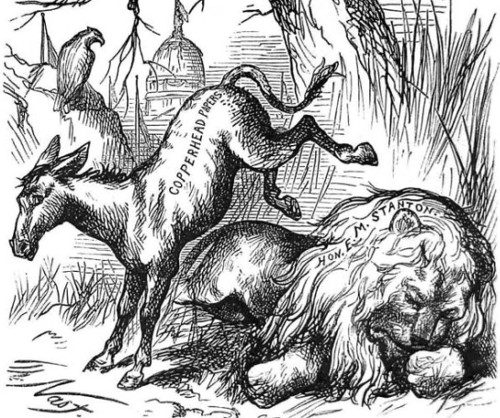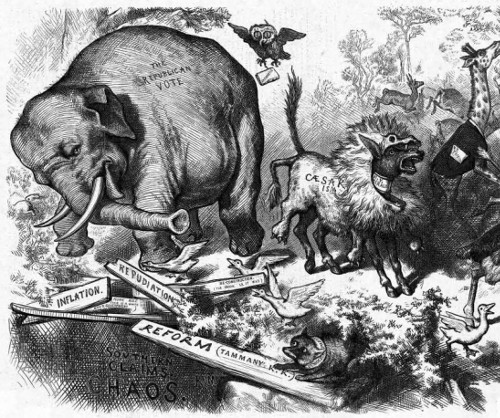|
The Origin of the American Political Party Animals
The United States' two largest political parties, the Democratic Party and the Republican Party, have long been represented by animal symbols: the donkey and the elephant, respectively. Those representations date to the 19th Century. Many sources say that the donkey as a representation of the Democratic Party dates to the 1820s, when Andrew Jackson was a dominant figure in America and the Democrats' standard-bearer. The party was relatively new on the scene at that stage, and Jackson was its first prominent candidate. He ran for President initially in 1824 and won the popular vote; however, he did not receive enough votes in the Electoral College and lost the subsequent electoral tally. He ran again in 1828 and was elected by a wide margin and then re-elected four years later. The other dominant political party in the 1820s was the Whig Party, and it was members of that party who took to disparaging Jackson and the Democrats by using a symbol of a donkey. Another name for donkey has long been jackass, and critics of Jackson took little time in finding that his full name could be disparagingly written as "Andrew Jack-ass," or "A. Jack-ass." Jackson had made no secret of his enmity for the Bank of the United States (and indeed succeeded in eliminating it), and some enterprising metalsmiths created medals that criticized Jackson and included an image of a donkey. Jackson turned the criticism around and embraced the donkey, emphasizing its attributes of steadfastness and determination as illustrations of the resolve of Jackson himself and of the Democratic Party as a whole. Jackson did not run for a third time and died in 1845. The next year, an illustrator named Thomas Nast came to America from his native Germany. He was a young boy at the time and studied design in New York City. He eventually got a job at Harper's Weekly as a cartoonist. During a three-decade career with the magazine, he saw published more than 3,000 of his cartoons. Among his famous illustrations was the now-familiar depiction of Santa as a jolly fat man. In 1870, Harper's Weekly published a Nast cartoon with the title "A Live Jackass Kicking a Dead Lion." The cartoon, which appeared on January 15, included words as well: On the donkey was written "Copperhead Papers"; on the lion was written "Hon. E.M. Stanton." Stanton was Edward Stanton, who had been Secretary of War under both President Abraham Lincoln and President Andrew Johnson and had died in 1869. "Copperhead" was a term used by members of the Republican Party to describe a large number of members of the Democratic Party in the North who had opposed the Civil War.  Certain northern newspapers were disparaging Stanton and his legacy at the time that Nast published his cartoon. Nast chose to "lionize" Stanton, to depict him as having done great things. The depiction of the "Copperheads," or Democrats as a donkey had a more lasting effect. And just four years later, another Nast cartoon included not only a depiction of the Democratic Party as a donkey but also the Republican Party as an elephant. In that Nov. 7, 1874 cartoon, the donkey is shown wearing a lion's skin, reminding viewers of the 1870 donkey-kicking-lion cartoon but perhaps also suggesting that the Democratic Party was being disingenuous by presenting itself as something it was not. More prominent in that cartoon is a large elephant, and written on the elephant was "The Republican Vote." It was by no means the last such depiction of that party using that animal.  The cartoon shows the elephant breaking bits of wood on which are written planks of the Republican Party platform, a not-so-subtle jab suggesting that the political party was not pursuing what it had promised to pursue in the 1872 election. President Ulysses S. Grant, a Republican, had been re-elected in that year. The donkey-elephant cartoon appeared in the middle of Grant's second term. The title of the cartoon is "Third-term Panic" and, historians say, was a reference to the upcoming 1876 election and the possibility that Grant would have a third successive term in office. At least one Illinois newspaper used the elephant to describe then-presidential candidate Abraham Lincoln, emphasizing the elephant's strength and determination–much like the attributes of the donkey that Jackson had emphasized. As well, an 1864 advertisement trumpeting Lincoln's re-election used an image of elephant to deliver the news. It was the 1874 Nast cartoon, however, that cemented in the minds of other cartoonists, and indeed other Americans, the idea that the elephant should represent the Republican Party and the donkey should represent the Democratic Party. |
Social Studies for Kids |
Social Studies for Kids
copyright 2002–2025
David White




